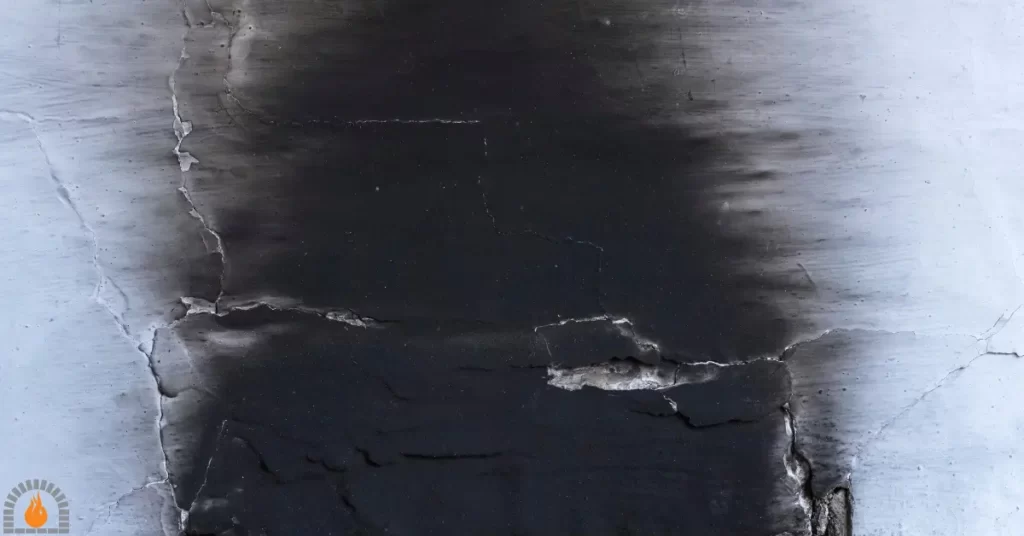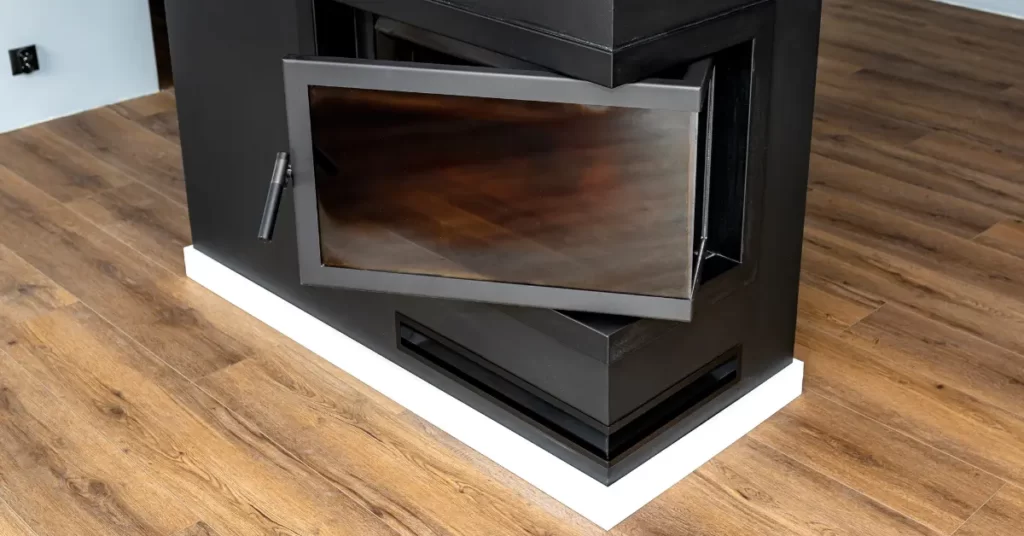Propane fireplaces offer a relaxed and convenient way to warm your home, creating a pleasant ambiance. However, you may encounter a frustrating issue: black soot buildup. Not only does it mar the appearance of your fireplace, but it can also indicate potential problems that need attention. So, what causes black soot from a propane fireplace?
One of the primary reasons for black soot formation in propane fireplace is incomplete combustion. When propane doesn’t burn completely, it releases soot particles into the air, settling on surfaces like the glass doors, walls, and furniture surrounding the fireplace.
However, there can be other reasons as well that may cause lampblack or carbon black in a propane fireplace.
This article will delve into the causes behind black soot from propane fireplaces and explore effective solutions to keep your fireplace clean and efficient.
How Propane Fireplace Work?
Before diving into the causes of black soot, let’s understand how propane fireplaces work. Propane fireplaces utilize propane gas as fuel, which is burned to produce heat and create the flame effect.
The propane is typically stored in a tank outside the house and delivered through a network of pipes to the fireplace. Understanding the components and mechanics of a propane fireplace will help us pinpoint the causes of black soot.
What Causes Black Soot from a Propane Fireplace?
- Incomplete Combustion
- Improper Flame Adjustment
- Low-Quality Propane or Contaminated Fuel
- Clogged Air Vents and Chimney
Major Causes of Black Soot from a Propane Fireplace
Incomplete Combustion
One of the primary reasons for propane fireplace black soot is incomplete combustion. When propane doesn’t burn completely, it releases soot particles into the air, settling on surfaces like the glass doors, walls, and furniture surrounding the fireplace.
Incomplete combustion can be caused by several factors, such as:
Oxygen Deprivation
Insufficient oxygen supply to the combustion process can lead to incomplete burning, resulting in soot formation. Ensure that your fireplace’s ventilation is not obstructed, and that proper airflow exists for optimal combustion.
Dirty Burner or Orifices
Over time, debris, dust, or spider webs can accumulate on the burner or orifices, disrupting the gas flow and affecting combustion and cause propane burner black soot.
Regular cleaning and maintenance of these components can help prevent soot buildup.
Improper Flame Adjustment
The flame in a propane fireplace should burn bright blue, indicating complete combustion. If the flame appears yellow or orange, it signifies an improper fuel-to-air ratio, which can contribute to soot production.
The following factors can cause improper flame adjustment:
Air Shutter Setting
The air shutter controls the amount of air mixed with the propane gas. An incorrect setting can lead to a rich or lean burn, affecting combustion efficiency.
Consult your fireplace’s manual or a professional to adjust the air shutter properly.
Gas Pressure Issues
Irregular or fluctuating gas pressure can disrupt the fuel-to-air ratio, leading to inefficient combustion. Regularly monitor the gas pressure and consult a technician if you suspect any problems.
Low-Quality Propane or Contaminated Fuel
The quality of propane and the presence of impurities can also contribute to soot formation. Inferior quality propane or fuel contaminated with oil, dirt, or water can affect combustion and lead to increased soot production.
Obtaining propane from reputable suppliers and ensuring the fuel is clean and pure is advisable.
Clogged Air Vents and Chimney
Blocked air vents and chimneys can hinder proper airflow and ventilation, causing incomplete combustion and subsequent soot buildup.
Regularly inspect and clean the air vents, chimney, and flue to maintain unobstructed pathways for releasing combustion byproducts.

Solutions to Prevent Propane Fireplace Black Soot
To minimize or eliminate black soot from your propane fireplace, consider implementing the following preventive measures:
- Clean the burner, orifices, and other fireplace components periodically to remove dirt, debris, and soot residues. This helps maintain optimal combustion efficiency.
- Ensure adequate airflow by keeping air vents and chimneys clear from obstructions. Regularly inspect and clean and maintain these areas to prevent soot buildup and other combustion byproducts.
- The air shutter and gas pressure are checked according to the manufacturer’s guidelines. Aim for a bright blue flame to ensure complete combustion and minimize soot formation.
- Source propane from reputable suppliers to ensure high-quality fuel free from contaminants. This will contribute to cleaner and more efficient combustion.
- Schedule regular professional inspections of your propane fireplace to identify potential issues contributing to soot buildup. Prompt repairs and maintenance can prevent further problems and keep your fireplace running optimally.
Read More from Our Fireplace Guide:
Is Black Soot from Propane Fireplaces Dangerous?
Black soot emitted from a propane fireplace can be dangerous if improperly managed. Black soot indicates incomplete combustion of the propane, which releases carbon monoxide (CO) and other harmful substances.
Carbon monoxide is extremely dangerous if inhaled in high concentrations.
Exposure to carbon monoxide can result in symptoms such as headaches, dizziness, nausea, and confusion; in severe cases, it can cause unconsciousness or death.
It is crucial to ensure proper ventilation and maintenance of the propane fireplace to minimize the risk of carbon monoxide buildup.

Safety Precautions for Using Propane Fireplace
When using a propane fireplace, it’s important to follow safety precautions to ensure the well-being of yourself and others. Here are some guidelines to consider:
Familiarize yourself with the instructions provided by the manufacturer for your propane fireplace. Follow them carefully to ensure safe operation and maintenance.
Ensure that the area where the propane fireplace is installed has proper ventilation. Propane produces carbon monoxide, which can be harmful if not properly vented. Ensure there is sufficient airflow to prevent the buildup of carbon monoxide gas.
You must install a carbon monoxide detector where the propane fireplace is located. The detector will alert you to any dangerous levels of carbon monoxide, providing an early warning.
Keep the area around the propane fireplace clear of flammable materials, such as curtains, furniture, or paper. Maintain a safe distance to prevent accidental fires.
Have a fire extinguisher readily available near the propane fireplace. Ensure you are familiar with its proper usage and that it is in good working condition.
Schedule regular inspections and maintenance for your propane fireplace. Hire a professional technician to check for leaks, damage, or other safety concerns. This is especially important if your fireplace is older or you suspect any issues.
Store propane cylinders or tanks in a well-ventilated outdoor area, away from any ignition sources. Follow the guidelines provided by your propane supplier for safe storage and handling.
Never leave the propane fireplace unattended while it is in use. Always ensure that someone is in the area and can monitor its operation.
Keep children and pets safe from the propane fireplace. Educate them about the potential dangers and ensure they understand that it is not a toy.
Establish and communicate emergency procedures with all household members. Ensure everyone can safely shut off the propane supply and evacuate the area if necessary.
My Final Thoughts
What causes black soot from a propane fireplace? Incomplete combustion, improper flame adjustment, low-quality propane, and clogged air vents are common culprits of soot formation.
Black soot from a propane fireplace can be a frustrating issue that affects the appearance and efficiency of your heating source. Understanding the causes behind this problem is essential to address and prevent it effectively.
By implementing regular cleaning and maintenance, ensuring proper ventilation, adjusting the flame correctly, and using quality fuel, you can minimize black soot and enjoy a clean and efficient propane fireplace.
Affiliate Disclosure: Fireplaceadviser.com is a participant in the Amazon Services LLC Associates Program. We may earn a commission when you click on certain links on this site and purchase.

Hello!! I am Jamal Khan. I often fix my home electric heaters and gas stove problems and research the common issues in the heating units to improve my knowledge and expertise. The aim of establishing fireplaceadviser.com is to share my expertise and knowledge with my audience.












